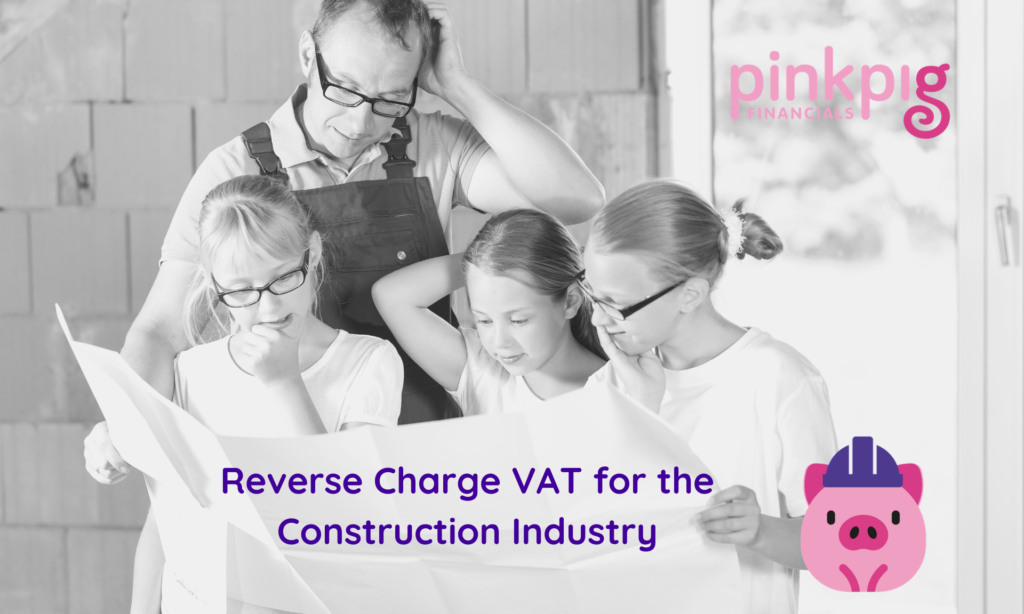Edit!! – Since writing and publishing this blog HMRC have now delayed this until 1st October 2020 – here is their notice on the delay. Their resoning for the delay is to give businesses affected more time to prepare for the change, and so it does not co-incide with Brexit!!
And then due to Covid it’s now been put back to 1st March 2021! But who knows if it will actually come in at this point, or will be delayed again – we shall wait and see!
Keep reading for all the info on the changes!
What is Reverse Charge VAT for the Construction Industry and how will it affect me?
This new regulation intends to cut down on ‘missing trader’ fraud – where companies receive amounts of VAT from their customers, but do not declare or pay this to HMRC.
The Domestic Reverse Charge (DRC) has been around for a while for some industries but is now is being extended and comes into force from 1st March 2021 (was originally 1st October 2019) for the construction industry.
If you’re VAT registered there are some changes you need to be aware of – carry on reading!
If you’re not VAT registered, then you don’t need to worry, just carry on as normal – happy days!
Sales between subcontractors and contractors will be subject to the Reverse Charge, unless they are sales to a contractor that’s an end user – ie, someone who uses the construction services for themselves rather than selling these as part of their construction business.
Changes to sales invoices to your clients
It is up to you to get confirmation from your customer if they are the end user or a contractor for reverse charge VAT.
If your customer is the end user, then you need to add VAT to your invoice for labour and materials as normal.
If your customer is a contractor, then you don’t charge VAT on your invoice. When raising your invoices in Xero you’ll need to select the Reverse Charge option under tax rate.
Changes to invoices from your sub-contractors
Speak to your sub-contractors to confirm to them that you are a contractor and that they no longer charge you VAT on their labour and materials.
Obviously if your sub-contractors are not VAT registered then this doesn’t apply to them and just continue as normal!
You will now need to include your sub-contractor’s VAT on your VAT return under the ‘reverse charge’ rules – so this means that you add it to one part and deduct from another part of the return – so in effect they cancel each other out and you are not out of pocket. The good news is if we are doing your bookkeeping and VAT returns, we will handle this whole process for you – just submit your receipts/invoices as normal.
If you handle your own bookkeeping, and VAT returns, then similarly with the sales side you’ll need to select the Reverse Charge option under tax rate when entering a bill onto Xero.
Are there any other changes we need to know?
Yes – if you are using the cash scheme for your VAT accounting, then you’ll need to change over to accrual for your first VAT return after the 1st March 2021. An adjustment will need to be made for any unpaid invoices and bills as of the final date of your last VAT return to ensure they are included on your first accrual basis return. I would recommend getting help from your accountant with this to ensure everything is properly accounted for.
If you are currently using the flat rate, then you will need to review your customers – if you mainly sell to contractors then you won’t have any sales VAT anymore (or very little) therefore the flat rate will actually end up costing you a lot more! You’ll need to advise HMRC of your withdrawal from the flat rate scheme and switch to the accrual basis. Again, we would recommend you speak to your accountant and get help with this as it is not as straight forward as it seems.
Either way if the majority, or all, of your customers are contractors, you’ll no longer be charging VAT and therefore you’re more than likely to be getting refunds each quarter rather than having bills to pay. And being on the accrual basis will then actually be more helpful as in some cases you’ll be able to claim the VAT back on supplier purchases before you’ve even paid the bills – ie those on credit terms!
Are all construction services included?
As usual nothing with HMRC is that straight forward – some construction services are included within these new rules – and some aren’t! Here is a list of services from HMRC and whether or not they are included within these new rules:
Included services:
- constructing, altering, repairing, extending, demolishing or dismantling buildings or structures (whether permanent or not), including offshore installation services
- constructing, altering, repairing, extending, demolishing of any works forming, or planned to form, part of the land, including (in particular) walls, roadworks, power lines, electronic communications equipment, aircraft runways, railways, inland waterways, docks and harbours
- pipelines, reservoirs, water mains, wells, sewers, industrial plant and installations for purposes of land drainage, coast protection or defence
- installing heating, lighting, air-conditioning, ventilation, power supply, drainage, sanitation, water supply or fire protection systems in any building or structure
- internal cleaning of buildings and structures, so far as carried out in the course of their construction, alteration, repair, extension or restoration
- painting or decorating the inside or the external surfaces of any building or structure
- services which form an integral part of, or are part of the preparation or completion of the services described above – including site clearance, earth-moving, excavation, tunnelling and boring, laying of foundations, erection of scaffolding, site restoration, landscaping and the provision of roadways and other access works
Excluded services:
- drilling for, or extracting, oil or natural gas
- extracting minerals (using underground or surface working) and tunnelling, boring, or construction of underground works, for this purpose
- manufacturing building or engineering components or equipment, materials, plant or machinery, or delivering any of these to site
- manufacturing components for heating, lighting, air-conditioning, ventilation, power supply, drainage, sanitation, water supply or fire protection systems, or delivering any of these to site
- the professional work of architects or surveyors, or of building, engineering, interior or exterior decoration and landscape consultants
- making, installing and repairing art works such as sculptures, murals and other items that are purely artistic
- signwriting and erecting, installing and repairing signboards and advertisements
- installing seating, blinds and shutters
- installing security systems, including burglar alarms, closed circuit television and public address systems
You can read further HMRC guidance here (make sure you grab a coffee though as it’s quite hard going!). As always we are here to help so if you have any questions on DRC and how it will affect you please just ask.

